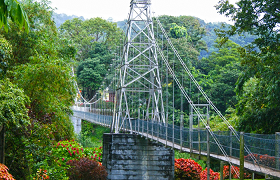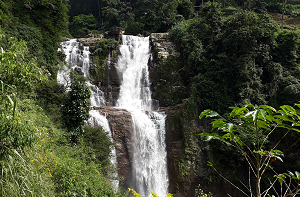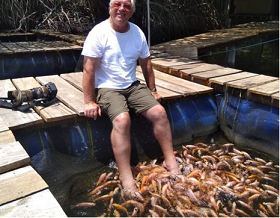Elephant Orphanage is an orphanage, nursery and captive breeding ground for wild Asian elephants located at Pinnawala village, in Sabaragamuwa Province of Sri Lanka. Pinnawala has the largest herd of captive elephants in the world. In 2011, there were 96 elephants, including 43 males and 68 females from 3 generations, living in Pinnawala.The orphanage was founded to care and protect the many orphaned unweaned wild elephants found wandering in and near the forests of Sri Lanka.On the way visit a spice garden in Mawanella to see many different types of spices Sri Lanka is famous for. Just 26 km from the hill capital of Kandy, the spice gardens are among the best on the island. You will be introduced to different spices and shown how some of these spices are grown and processed.
Kandy is a major city in Sri Lanka located in the Central Province. It was the last capital of the ancient kings' era of Sri Lanka. The city lies in the midst of hills in the Kandy plateau, which crosses an area of tropical plantations, mainly tea. Kandy is both an administrative and religious city and is also the capital of the Central Province. Kandy is the home of The Temple of the Tooth Relic , one of the most sacred places of worship in the Buddhist world. It was declared a world heritage site by UNESCO in 1988. A stroll across this small lakeside town - cradled among the misty hills - will feature the Kandy City Center - bundled with latest and world class brands, a bazaar, an art & crafts center, as well as a gem museum & lapidary. Fine tube your evening by stepping to the beat of traditional music & drumming amplified by a cultural show enhancing the rich and vibrant culture of the wonder of Asia, Sri Lanka.
Peradeniya is a suburb of the city of Kandy in Sri Lanka. Peradeniya is famous for the Royal Botanical Gardens, peradeniya are about 5.5 km to the west of the city of Kandy in the Central Province of Sri Lanka. The history of this garden dates back to 14th century. But it has been converted as botanical garden in 1821 by Alexander moon a , a british officer. The finest of its kind in Asia, the largest botanical garden in Srilanka.The total area of the botanical garden is 147 acres (0.59 km2), close to the river bank of mahaveli the longest river in Srilanka. The elevation is 460 meters above the sea level, with a 200-day annual rainfall. It is renowned for its collection of orchids. The garden includes more than 4000 species of plants, including orchids, spices, medicinal plants and palm trees and over 10000 trees are here. Attached to it is the National Herbarium of Sri Lanka. It is managed by the Division of National Botanic Gardens of the Department of Agriculture.
Tea production is one of the main sources of foreign exchange for Sri Lanka. Sri Lanka is the world's fourth-largest producer of tea.The humidity, cool temperatures, and rainfall of the country's central highlands provide a climate that favors the production of high-quality tea. The industry was introduced to the country in 1867 by James Taylor, a British planter who arrived in 1852.Just step into a tea factory processing the prestigious brand of Ceylon Tea, to observe a rich tradition kept alive up to date. As you Observe the hissing and swishing of machines, inhaling the heavenly scent arising from these facilities, make sure to end your day in style over a perfectly blended cup of pure Ceylon Tea.
Nuwara Eliya is a city in the hill country of the Central Province, Sri Lanka. Its name means "city on the plain " or "city of light". The city is the administrative capital of Nuwara Eliya District, with a picturesque landscape and temperate climate. The elevation is 1868m(6128ft) above from the sea level. Then for it has a subtropical climate, The city attracts many tourists around the world. And as well as Srilankans, even during the colonial period of the british 19th 20th centuries. This was the plase were the British officers came for the recreational works. Such as play golf, cricket, hunting and many more. There for even today we can see witness many colonial buildings in the surrounding and the Nuwara Eliya referred as little England.
Kitulgala is a small town in the west of Sri Lanka. It is in the wet zone rain forest, which gets two monsoons each year, and is one of the wettest places in the country. Kithulgala white water rafting is one of famous watersports, especially during rainy days which make lot thrills for the rafters. Two of guides come along in the boat, where they take the riders through bends and ups and downs for about 4km distance. End of the trip can have jump to the water under their supervision. The Academy Award-winning The Bridge on the River Kwai was filmed on the Kelani River near Kitulgala. Kitulgala is also a base for white-water rafting,which starts a few kilometres upstream and also popular as a location for adventure based training programs.
Bentota is a coastal town in Sri Lanka, located in the Galle District of the Southern Province, governed by an Urban Council. It is approximately 65 kilometres (40 mi) south of Colombo and 56 kilometres (35 mi) north of Galle. Bentota is situated on the southern bank of the Bentota River mouth, at an elevation of 3 metres (9.8 ft) above the sea level. The name of the town is derived from a mythical story which claims a demon named 'Bem' ruled the tota or river bank.
Balapitiya is a coastal town, in south west Sri Lanka. The most important asset of the fragile eco-system of Madu River is its mangrove forests. These mangrove forests are providing protection for a large number of aquatic bird, animal and plant species. The eco-system in Madu River is the home for different kinds of aquatic plants, crabs, shrimps, fish, insects, amphibians and other animal life including crocodiles. Madu River is inhabited by a large number of animals and its bio-diversity is at very high level. This ecological complex is a Ramsar wetland and it is the second largest wetland on the island. 28 islands (some of them are inhabited by humans) are included in the Madu River estuary. The extent of the Madu River wetland is 915 hectares and harbours multi-varied Bio-diversity Eco-systems. There is no road network connecting the island and mainland and the boat is the main source of transport for the people living on the islands. The Kotduwa Buddhist temple occupies an island and it is the main religious institution for the people, who live on Madu River. Kothduwa temple is an important tourist attraction and visited by many tourists, who undertake the Madu River safari. Madu River is one of the best places to witness the different types of mangroves in the country.
The Turtle Care Centre at Kosgoda beach is one of 18 turtle hatcheries along the southern coast of Sri Lanka. The centre is located in the South Western coastal village of Kosgoda and was establised in 1981. It is also very popular as all five species of turtles that visit Sri Lanka nest in Kosgoda. This is not so with many of the other hatcheries around the island whose beaches host only some of the species.
Galle is a major city in Sri Lanka, situated on the southwestern tip, 119 km from Colombo. Before the arrival of the Portuguese in the 16th century, when it was the main port on the island. Galle is the best example of a fortified city built by the Portuguese in South and Southeast Asia, showing the interaction between Portuguese architectural styles and native traditions.The Galle fort is a world heritage site in Asia.
Transfer Form Colombo To Ariport For Departure





































